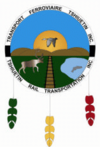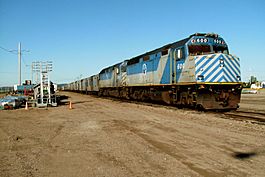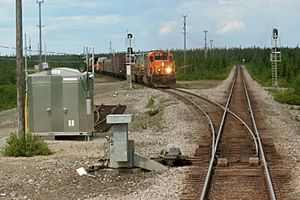Tshiuetin Rail Transportation facts for kids
Quick facts for kids Tshiuetin |
|
|---|---|
 |
|

A train at Sept-Îles departing for Schefferville
|
|
| Overview | |
| Other name(s) | North Wind |
| Status | Active |
| Owner | |
| Locale | Quebec and Labrador |
| Coordinates | 53°04′04″N 66°12′11″W / 53.0676959°N 66.2031418°W |
| Termini | Emeril Schefferville |
| Website | www.tshiuetin.net |
| Service | |
| Type | Heavy rail |
| History | |
| Opened | December 1, 2005 |
| Technical | |
| Track length | 217 km (135 mi) |
| Track gauge | 1,435 mm (4 ft 8 1⁄2 in) |
Tshiuetin Rail Transportation Inc. is a special railway company in Canada. It owns and runs a train line that goes through the wild areas of western Labrador and northeastern Quebec. This railway connects Emeril, Labrador, to Schefferville, Quebec.
The company also helps run another railway line. This line connects Sept-Îles, Quebec to Emeril. Tshiuetin Rail Transportation is very important because it is the first railway in North America that is owned and operated by Indigenous peoples. It is owned by three different Indigenous groups: the Innu Nation of Matimekush-Lac John, the Naskapi Nation of Kawawachikamach, and the Innu Takuaikan Uashat Mak Mani-Utenam.
History of the Tshiuetin Railway
Tshiuetin Rail Transportation operates on a part of the railway called the Menihek Subdivision. This section runs from Emeril Junction to Schefferville. Before Tshiuetin Rail took over, this line was part of a bigger railway built between 1951 and 1954.
In 1983, the iron mine in Schefferville closed down. After that, the railway company that owned the line focused more on other routes. The Emeril Junction to Schefferville line then had fewer trains. It mostly carried goods and provided passenger service for the First Nations communities living in the area. This passenger service was supported by the government.
By 2006, the Canadian government saw that train service was the only way for people to travel to and from Schefferville by land. The original railway company wanted to sell the Menihek Subdivision. However, no other railway companies wanted to buy it.
How Indigenous Communities Acquired the Railway
Three local First Nation councils decided to work together. They formed a single company to buy the railway line. This company was Tshiuetin Rail.
In 2004, Tshiuetin Rail received a special permit from the Canadian Transportation Agency. This permit allowed them to operate a railway. They bought the Menihek Subdivision "as is," meaning they took it in its current condition. The company agreed to provide all passenger train services and some freight services. They also agreed to help with passenger service on another line that connects Sept-Îles to Emeril Junction.
Tshiuetin Rail began running trains on December 1, 2005. This happened after an agreement was made between the three Indigenous owners of Tshiuetin Rail and the owners of the Quebec North Shore and Labrador Railway (QNSX). As part of this agreement, QNSX sold its Menihek Subdivision for a very small amount of money.
This agreement was a big step. It made Tshiuetin Rail the first railway line in Canada to be owned by Indigenous peoples.
The Isolated Railway Network
The Tshiuetin railway, along with a few other lines like the QNSX line, forms a special railway network. It is "isolated" because it does not connect directly to the main North American railway system.
However, there is a way for trains to connect. A company called Compagnie de gestion de Matane operates a train ferry service. This ferry carries trains between Sept-Îles and the port at Matane. The port at Matane does connect to the larger North American rail network.



